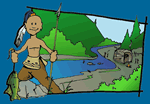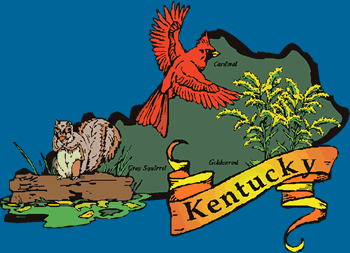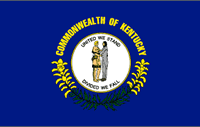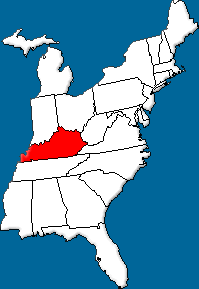


Geography and Landforms:
Kentucky is composed of five geographic regions:
|
 History:
During the Revolutionary War (1775-1783), Native Americans who sided with Britain attacked Kentucky settlements. For protection, territorial settlements in what would eventually be Kentucky became part of Virginia in 1776. In 1778, Virginians captured three British trading posts that were supplying weapons to the Indians. This helped to end most of the attacks against Kentucky settlers. The last major Indian raid in Kentucky occurred at the Battle of Blue Licks in 1782, although small skirmishes and raids continued until 1813.
|
 Economy:
After its admission to the Union as the fifteenth state, Kentucky prospered and agriculture became the economic mainstay for the Commonwealth. Tobacco had become Kentucky's primary cash crop by 1787. Kentucky was also a leading producer of the world's hemp supply, used for making rope and fiber products until jute became popular in the early 1900's. Corn, also produced in Kentucky, was difficult to transport in dried form, and was transported more easily when distilled into whiskey.
|
 First Inhabitants:
Kentucky's first human inhabitants were descendants of prehistoric peoples who migrated from Asia over an artic land bridge to North America around 30,000 years ago. When Hernando de Soto entered Kentucky on May 10th, 1541, he described one Indian Tribe in Western Kentucky between the Cumberland and Ohio Rivers, calling them by slightly different names, ranging from Quizquiz (influenced by a place name of renown from DeSoto's Conquest of Peru) to Quizqui to Chisca, all sounding about the same in their language. The French would call them Casqui and the English Kashinampo. That tribe shared a unique language with the Casqui of Southern Indiana, the Alabamu of Central Tennessee and the Coste of Eastern Tennessee. They lived next to each other when DeSoto visited each of them, but that entire Indian language group would be scattered well before being described by later Europeans.
|
Books Related To KentuckyB is for Bluegrass: A Kentucky Alphabet - Mary Ann Riehle The Champ: The Story of Muhammad Ali - Tonya Bolden Chasing Redbird - Sharon Creech Danger at Sand Cave - Candice Ranson Dexter the Tough - Margaret Peterson Haddix Dream of Night - Heather Henson Faith, Hope, and Ivy June - Phyllis Reynolds Naylor My Mountain Song - Shutta Crum Runaround - Helen Hemphill Tadpole - Ruth White Trouble Don't Last - Shelley Pearsall |
Famous Citizens:
|
| Capital: | Frankfort |
| Entered Union: | June 1, 1792 |
| Population: | 4,413,457 |
| Area | 40,409 |
| Bird | Cardinal |
| Flower | Goldenrod |
| Nickname: | Bluegrass State |
| Governor | Steven Beshear |
Places to Visit in Kentucky: (Click the links to learn more.)
|



